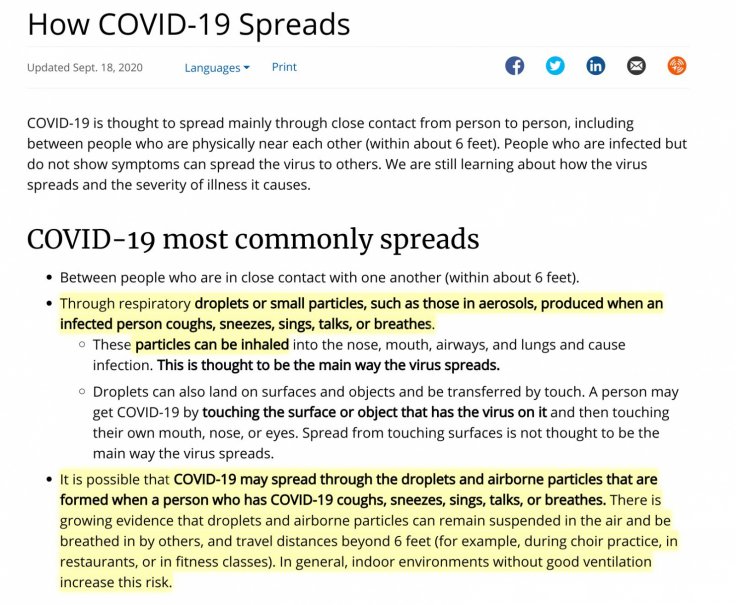As the Coronavirus pandemic enters the ninth month, there has been great debate about how the virus spreads. While a human-to-human transmission is already established, of late another mode of transmission has been doing rounds.
There have been studies to see if the virus is airborne and if it spreads through tiny aerosol particles. The U.S. Center for Disease Control and Prevention (CDC) also put up guidance on September 18 that it does spread through the air. However, the agency has backtracked.
As per the CDC's now reverted guidance, the tiny particles could remain suspended in the air and could travel beyond six feet — the recommended social distancing rule. The agency also recommended the use of air purifiers so that it could prevent the spread indoors. However, on Monday (September 21), the agency said it erroneously posted the guidance.

So, Does It Spread Through Air or Not?
The CDC's backtracking on its guidance for obvious reasons hasn't gone down well with netizens. Some pointed to the recent report that claimed the CDC had changed its reports on multiple occasions under pressure from the Trump Administration. However, the question remains on whether the virus spreads through the air or not. Let's first understand the science behind the possibility.
When a person exhales, that individual generates big and tiny respiratory droplets or aerosols. While the big droplets (>5 µm) evaporate, microscopic droplets(≤5 μm) have the potential to be inhaled into the lower respiratory tract in the lungs.
A recent study published in August suggested that not only the microscopic droplets remain suspended in the air, but it could also travel beyond the six-feet distance. The study which was conducted by researchers from the University of Twente and the University of Rome Tor Vergata in Italy also found that humid air could also play a major role in the spread.

Another study conducted by the U.S. National Institutes of Health (NIH) suggested that infected particles exhaled while breathing and coughing could remain in the air for up to eight to 14 minutes. A study by the New England Journal of Medicine also found that Coronavirus could be found in the aerosols for up to three hours.
What Does WHO Say?
Although in July, the World Health Organization (WHO) said that it could not rule out the possibility of airborne transmission, on its website, it said that the study was done in laboratory settings with "aerosols of infectious samples being generated using high-powered jet nebulizers." "These findings were from experimentally induced aerosols that do not reflect normal human cough conditions," WHO says.
Dr Mike Ryan, Executive Director of the WHO's Health Emergencies Program, during Monday's news conference, said that the United Nations agency had not seen "new evidence" on airborne particles spreading the virus and it was in touch with the CDC to "better understand" why it had made the change.
"Our position on this remains the same and we've always said going back over months and months about the potential for different kinds of roots of transmission and particularly driven by the context, the proximity, the intensity, the duration and the potential for different forms of transmission," Dr Ryan added.
What Does It Mean?
As far as the WHO and CDC are concerned, exhaled aerosols beyond six-feet distance do not pose a threat. However, as the situation is evolving and studies indicating that droplets might contain the virus and could spread, scientists would come to a conclusion soon. But the recommendation of using face covering and wearing a mask could be more important than ever to stop the spread.









